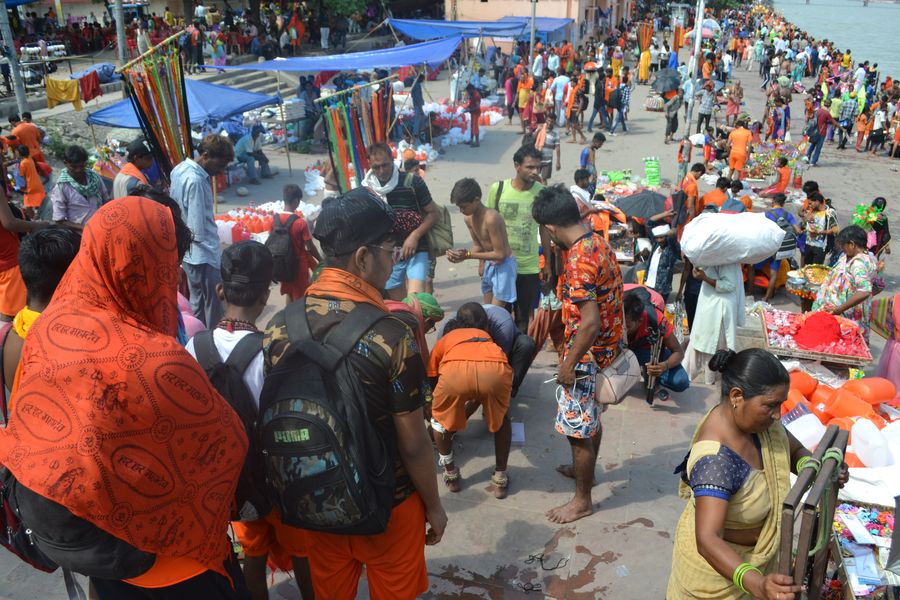
Beyond Club Cultures: The Mobile DJ and Devotional Music in North India
Independent Researcher
<https://dx.doi.org/10.12801/1947-5403.2021.13.01.10>
The history of electronic dance music in India can be dated back to the explosion of disco music in the early 1980s. In subsequent decades hip-hop, breakbeat, psychedelic trance and a number of other genres have entered the musical milieu through film and radio and, in recent years, the internet and streaming services. In this process, a number of local DJs and producers, as well as clubs and dance festivals have emerged. But electronic music has also gone beyond the club, to the highways and streets of the country and become embedded in a number of social phenomena. Here, I take you through one such phenomenon: the religious pilgrimage, specifically the kanwar yatra, an annual pilgrimage undertaken by devotees of the Hindu deity Siva in the auspicious month of sawan[1] (July-August).

Figure 1. Hawkers in Haridwar. Photo credit: Bharat S. (2019).
Every year in sawan men (and more recently women) from the north Indian states of Uttarakhand, Himachal Pradesh, Rajasthan, Punjab, Haryana, Uttar Pradesh, and Delhi gather at the pilgrimage town of Haridwar[2] situated in the foothills of the Himalayas where the sacred river Ganga enters the north Indian plains to take part in this ceremonial transportation of holy water from the river for libations at various shrines dedicated to Siva. Some arrive by bus and specially arranged trains, others drive down in large groups on trucks and tractors. The pilgrimage is notable for the considerable physical rigour it demands. Once in Haridwar pilgrims fill up containers with holy water from the river and begin the return journey on foot, with many walking anywhere from 100 to 300 miles within a span of ten days. Young adults and teenagers of low-income urban and rural backgrounds make up the bulk of the pilgrims, called kanwarias or bhole after Bholenath[3] in common parlance. The pilgrimage gets its name from the kanwar, the bamboo apparatus on which the water is transported, although in recent years more elaborate kanwars of fibreglass, styrofoam and metal have also become popular.

Figure 2. Pilgrims with their kanwars in Haridwar. Photo credit: Bharat S. (2019).
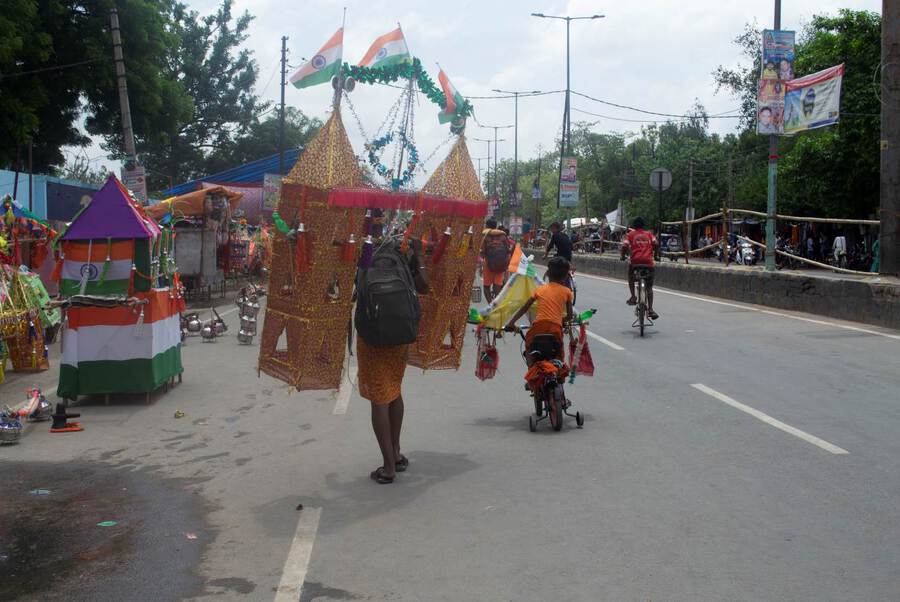
Figure 3. Kanwars of different sizes and shapes. Photo credit: Bharat S. (2019).
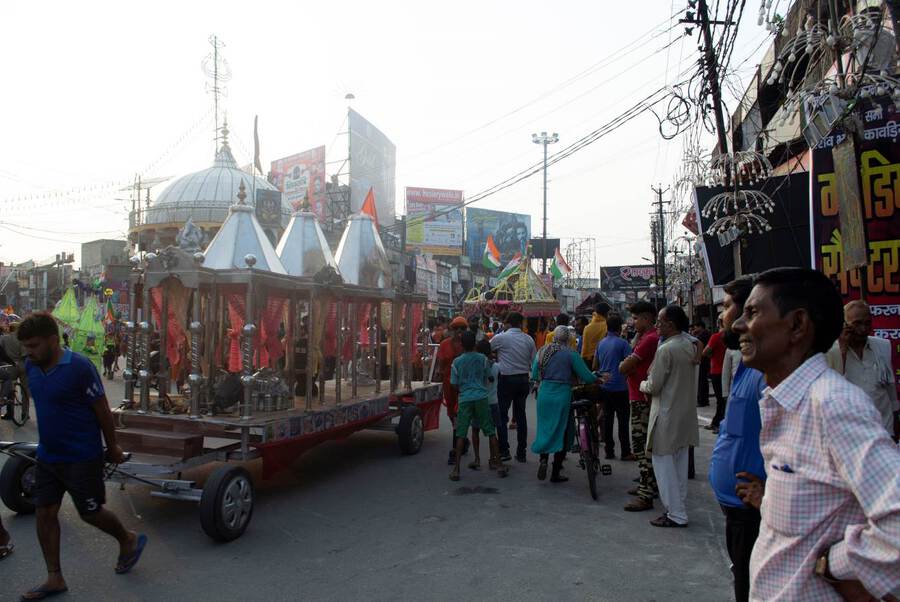
Figure 4. A jhanki (tableaux) kanwar being pulled by pilgrims on the streets of Muzaffarnagar. Photo credit: S. Bharat. (2019).
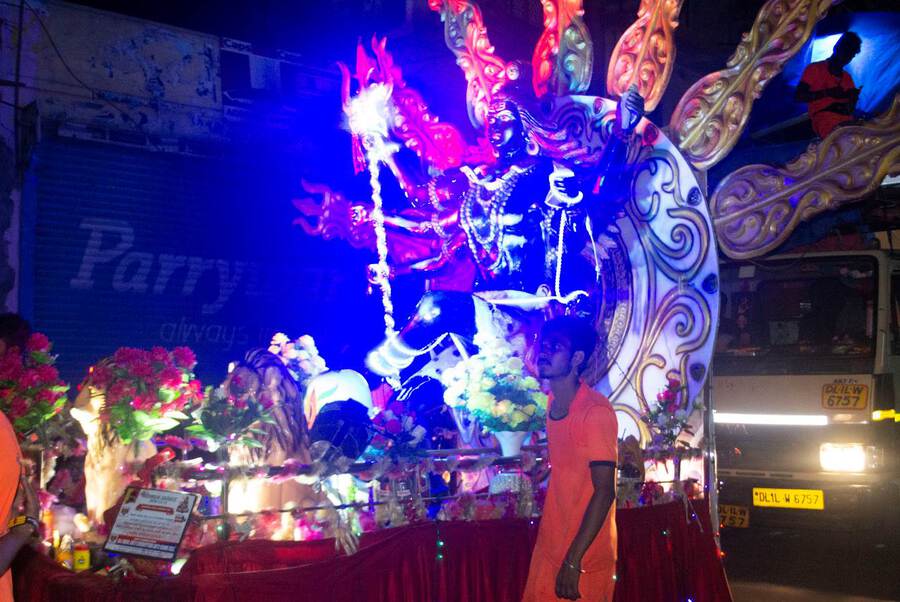
Figure 5. Another jhanki kanwar in Muzaffarnagar. Photo credit: S. Bharat. (2019).
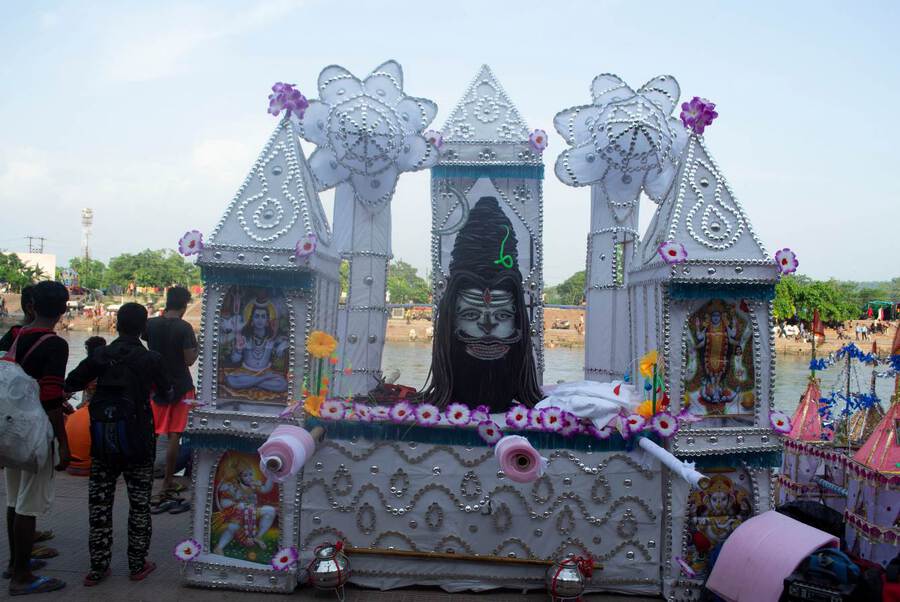
Figure 6. A large kanwar modelled after a temple shrine, Delhi. Photo credit: S. Bharat. (2019).
Concurrent with the pilgrimage’s growing popularity there has been a veritable explosion of kanwar music—beat driven electronic music with religious themes whose production is tailored to take maximum advantage of the sonic impact and reach offered by large PA systems rigged up on the backs of trucks, creating what is known locally as the “mobile DJ”.[4]

Figure 7. Pilgrims and bathers at Har ki Pauri, Haridwar. Photo credit: S. Bharat. (2019).
Take Figure 7, for instance, photographed at Har ki Pauri, the main ghat[5] of Haridwar during the sawan season in 2019. It is a photograph that may best be described as noisy. It is awash in bright colours crowded together—the saffron of pilgrims’ clothes, the yellow, pink and neon greens of their kanwars, the golden colour of tinsel and the deep red of the wet sandstone steps. Small-time hawkers and vendors thread their way through the mass of pilgrims. The auditory scene is as chaotic as the visual one. At the base of everything is the roar of the flowing river, accented by the splash of pilgrims diving into it, laughter and shouts and loud conversation. The trade cries of vendors and hawkers is another layer of sound added to this mix. Overlooking this are the loudspeakers, used variously to locate people separated from their friends or families in the crowd, to appeal for donations, to make public service announcements and crowd control, and to play prayer songs at auspicious hours of the day. Surrounding all of this is the relentless sound of traffic from the street. Out of sight, across the river, to the left, there is a sprawling mud field where pilgrims park their trucks. From these parked trucks, from time to time, an “open”[6] mobile DJ’s bass-y barrage breaks into this already crowded composition.

Figure 8. Buses and trucks parked on a field near the riverbank in Haridwar. Photo credit: S. Bharat. (2019).
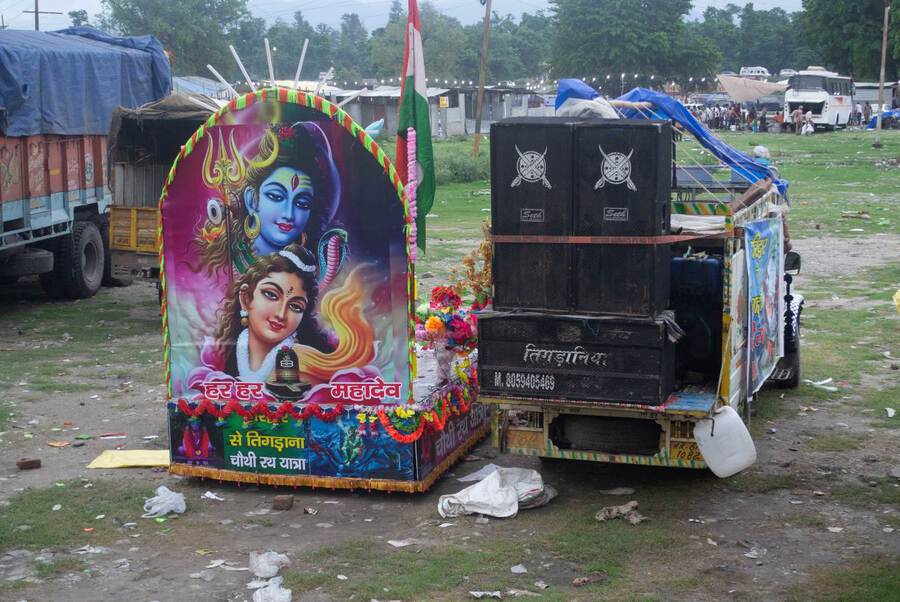
Figure 9. A small mobile DJ mounted on a pickup truck, next to the jhanki (tableaux) kanwar it will accompany. Photo credit: S. Bharat. (2019).

Figure 10. Front view of Figure 9. Photo credit: S. Bharat. (2019).
In what follows, I delve into this polyphonous “soundtrack” of the kanwar pilgrimage, using a combination of field recordings, commercially released music, YouTube clips and photographs accompanied by my own annotations and field notes. In doing so I embed this music within a larger field of sonic occurrences and the social processes they are tethered to and argue that our preponderant focus on the club floor often removes from sight other locations of electronic dance music cultures, particularly in the global south. I use the word soundtrack for three reasons. Firstly, to convey that sound is embedded within a broader social field where it may or may not enjoy performative primacy. A soundtrack can draw attention to itself, but it can also recede to the background. Secondly, unlike a soundscape the soundtrack bears no connotations of a totality or holism (Sterne 2013: 186). Tracks are layers that can be added up or silenced. Lastly, the term foregrounds the centrality of the mechanical reproduction of sound and its technological mediation through devices ranging from cell phones and Bluetooth speakers to sophisticated sound systems costing hundreds of thousand rupees.
The word pilgrims most commonly use to describe their disposition is shraddha (faith). In the kanwar pilgrimage shraddha is expressed through the laborious physical act of carrying the kanwar and adhering to the many niyam (rules) that govern the behaviour of a person bearing the kanwar. If shraddha is religious feeling in motion, then this soundtrack is one of its motors. Kanwar music is drawn from a common repertoire of songs about Siva that occupy an “intermediate sphere” (Manuel 2015) where folk, pop, film and devotional music overlap. Produced by regional music labels[7], they’re sung by popular folk singers of the region in a mix of Haryanvi, Punjabi, and Hindi—the language spoken by most of the pilgrims at Haridwar. The language is extremely colloquial, with a healthy mix of commonly heard English words. I offer examples of some of these tracks.
Nakli Bhang (Lang: Haryanvi) [Eng: Fake Bhang] (TauWood 2017)
Domestic disputes between Siva and his consort Parvati are a popular theme in kanwar songs. Here Siva accuses Parvati of giving him fake bhang (edible cannabis) and Parvati retorts that his growing tolerance is the problem, not the potency of the bhang.
Bhola Whatsapp Pe Aa Gaya (Lang: Haryanvi) [Eng: Bhola’s On Whatsapp Now] (Supertone Regional 2017)
Here technology and social media frame and mediate the hierarchical male homosocial relationship between deity and devotee, the latter occupying a fluid space somewhere between friend, fan, and follower. Bhola communicates with his devotees over the instant messaging platform WhatsApp. Another popular trope in these songs is to present the pilgrims as members of Siva’s baraat (wedding entourage); eg. “Bhole di Baraat”, “Shiv Ki Barat Hai”.
Bam Lahiri (Hindi) (Sony Music 2007)
One of the most well known songs of this genre is “Bam Lahiri” by Hindi playback singer Kailash Kher. While never marketed as a kanwar song, its imagery and style have become templates for newer tracks.
Before these songs reach the mobile DJ, they pass through the hands of a “mixer” who creates a “DJ mix” by adding layers of bass-driven beats and studio effects to the original track. These mixes are uploaded on Youtube and circulate via informal networks over WhatsApp and file sharing mobile apps.
Bhang Pili Gora Ne DJ Remix by DJ Somvir Muanaa (2021)
In this remix, very little of the original song’s structure is altered. The work of remixing a kanwar song is more about enhancing the song with a backing beat rather than reworking the song’s structure. This mix, like many others, incorporates the mixer’s name into it like an auditory watermark. In a system so fluid, informal and unregulated, this is often the only way of ensuring authorship. When heard in large gatherings, it also acts as an effective form of publicity.
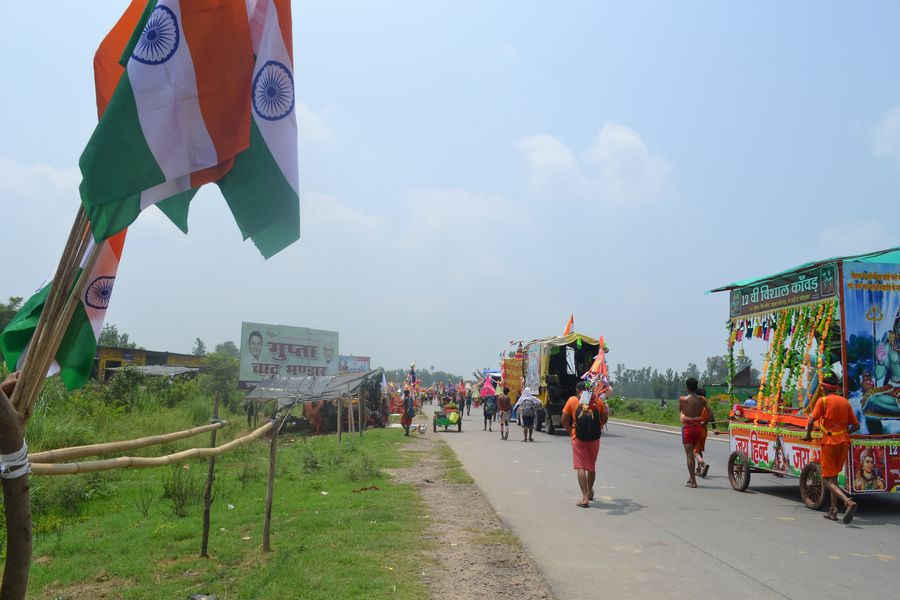
Figure 11. Pilgrims on the NH-334 near the Uttar Pradesh border. Photo credit: Bharat S. (2019).
Having been remixed by the DJ, the song passes into the hands of the mobile DJ operator. In its present form, the yatra is unthinkable without the deafening, rib-crushing throb of the mobile DJ’s rhythm track. A whole economy of motorized vehicles, music production, and sound reproduction technology is mobilised around it. A DJ setup for the kanwar yatra may range from something as simple as two speakers and a mixing console secured to the back of an autorickshaw to elaborate rigs involving multiple speakers and lights and a crew of helpers and mechanics to keep the machinery operational. The mobile DJ is a common phenomenon in North India, its uses ranging from wedding processions to political rallies and religious gatherings. Unlike loudspeakers, which are not designed to call attention to themselves, the mobile DJ apparatus is as much visual as it is auditory, rigged up with plastic garlands and tinsel and a bevy of strobe lights. Mobile DJs are hired by pilgrims to accompany them on the journey. The music enhances the spectacle of lights, and elaborately decorated tableaux. One pilgrim described it as a force that “keeps the feet moving”[8] despite the aches and pains, the swelling and the blisters that are an inevitable result of the journey.
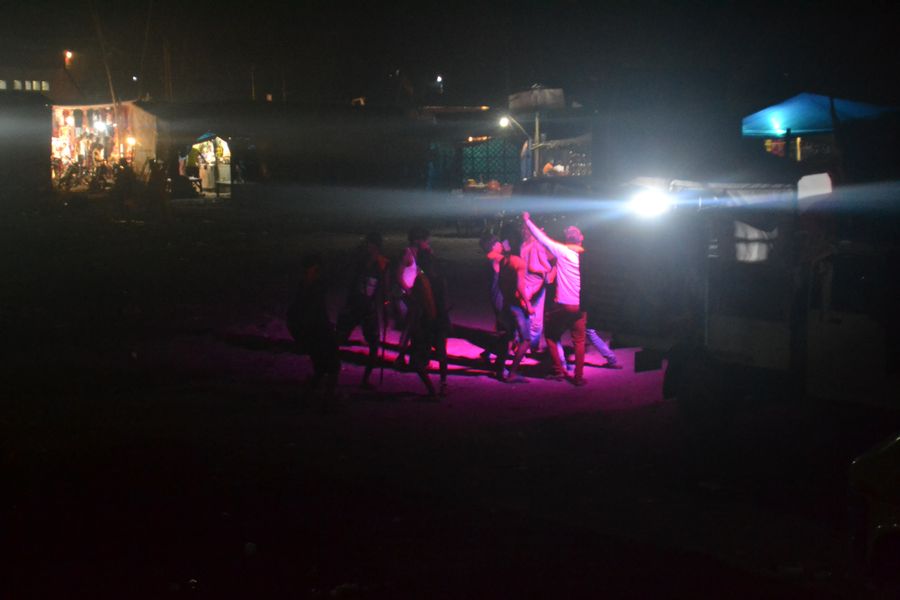
Figure 12. Pilgrims dancing in Haridwar. Photo credit: Bharat S. (2019).

Figure 13. A mobile DJ passing through Muzaffarnagar. Photo credit: S. Bharat. (2019).
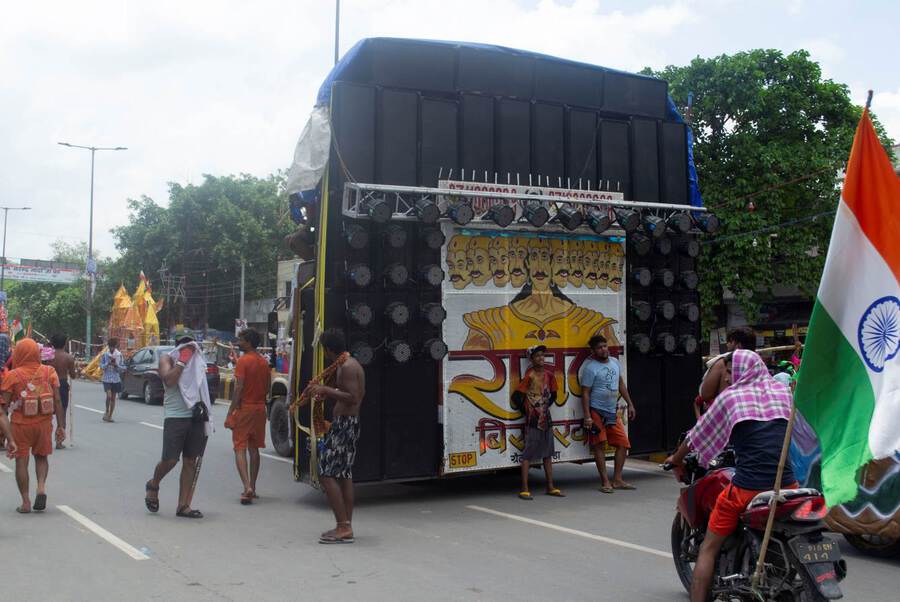
Figure 14. A massive mobile DJ setup with more than two dozen speakers of varying sizes. Photo credit: S. Bharat. (2019).
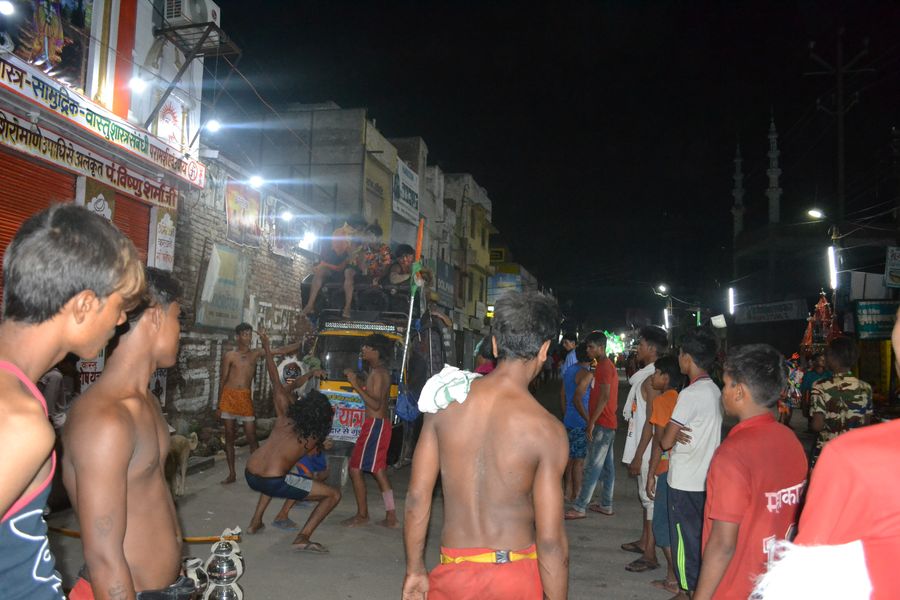
Figure 15. Pilgrims dancing on the streets of Muzaffarnagar. Photo credit: Bharat S. (2019).
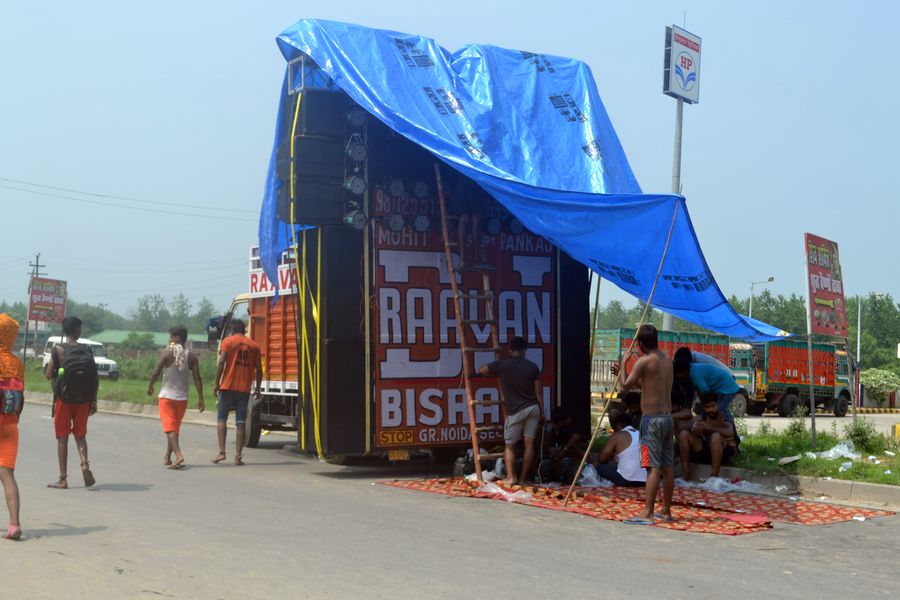
Figure 16. The crew of a mobile DJ system resting under a tarp. Photo credit: Bharat S. (2019).
Most mobile DJs are operated by young men attached to a sound system rental service, such as Raavan DJ, and learn through apprenticeship, starting out as helpers in the crew. It is the owner of the service who receives bookings and assigns the operators to gigs. Nitin is a 19 year old operator from Noida, Uttar Pradesh who started out as an apprentice three years ago. Like most operators, weddings[9] are the primary source of work for Nitin, but he has been booked twice for the kanwar yatra. As a paid service, his priority is to satisfy the client and farmaish (requests) are common and difficult to refuse. Key to sustaining the momentum of a mobile DJ performance is transitions:
The starting should be such that the public is excited that the DJ is playing… If a song, for instance, is three minutes long, we don't play it for the entire duration. At most we play the song for a minute…because we start getting requests once the music starts… It depends on the public, the way they are dancing. As I said, beat to beat… if I think the song is too slow, and I want the public to go faster, then I will think about what I can play to make them dance faster. When the beat kicks in, when there is a punch to it, it gets the public going[10].
The focus is not on the creation of a seamless groove through beatmatching and EQ work but on moving “beat to beat”—the rapid introduction of novelty to keep dancers on their toes by quickly cycling through songs—and the “punch” of an explosive beginning.
Haridwar During the Sawan Mela (Iyer 2019)
Here is a recording made on the banks of the Ganga one evening during the Sawan Mela in 2019. In less than a quarter of an hour, the operator cycles through nearly half a dozen popular tracks – Bhole di Baraat, Bam Lahiri, Bhola Bah Gaya Ganga Main, Sari Duniya Jhuman Lati O Chandre Sute Ne, Mast Malang, Akhiyan Udeek Diyan. To ears accustomed largely to club DJ-ing the effect is very disorienting at first.

Figure 17. Pilgrims on top of a mobile DJ. Photo credit: S. Bharat. (2019).
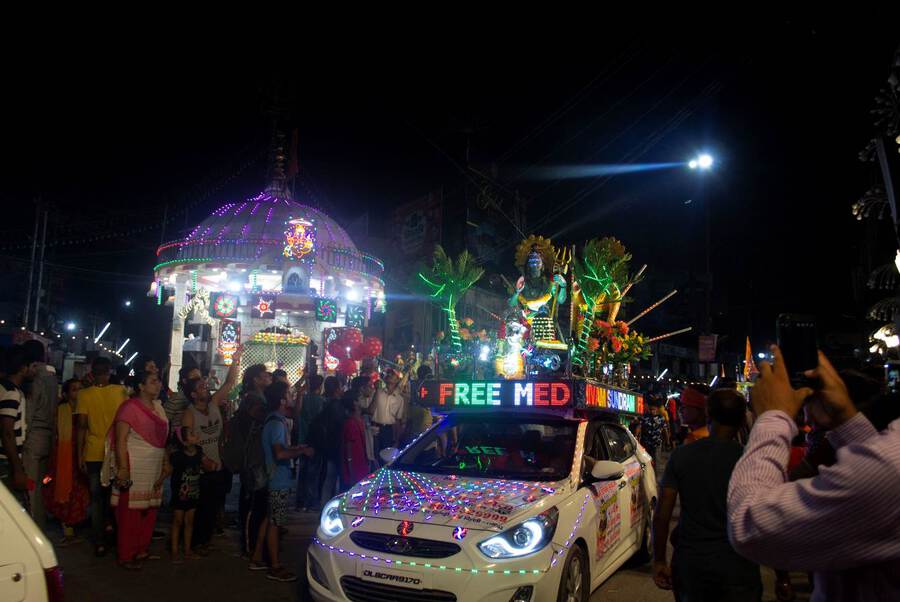
Figure 18. Residents gathered at Shiv Chowk in Muzaffarnagar, Uttar Pradesh in the evening to observe the passage of kanwars. Photo credit: S. Bharat. (2019).
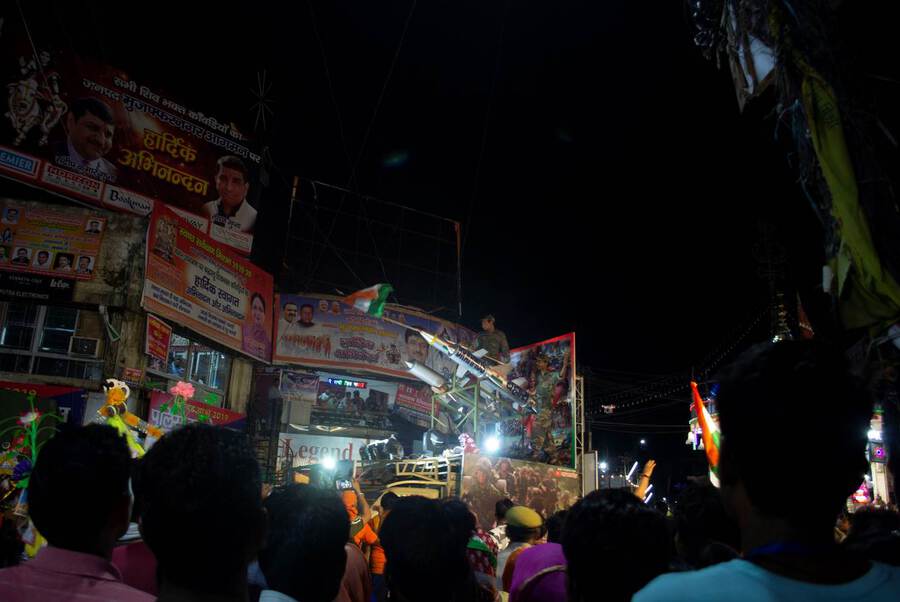
Figure 19. A military-themed jhanki (tableaux) with images of the Indian Armed Forces, actors dressed in military fatigues, and models of the Indian-made BrahMos cruise missile. Photo credit: S. Bharat. (2019).
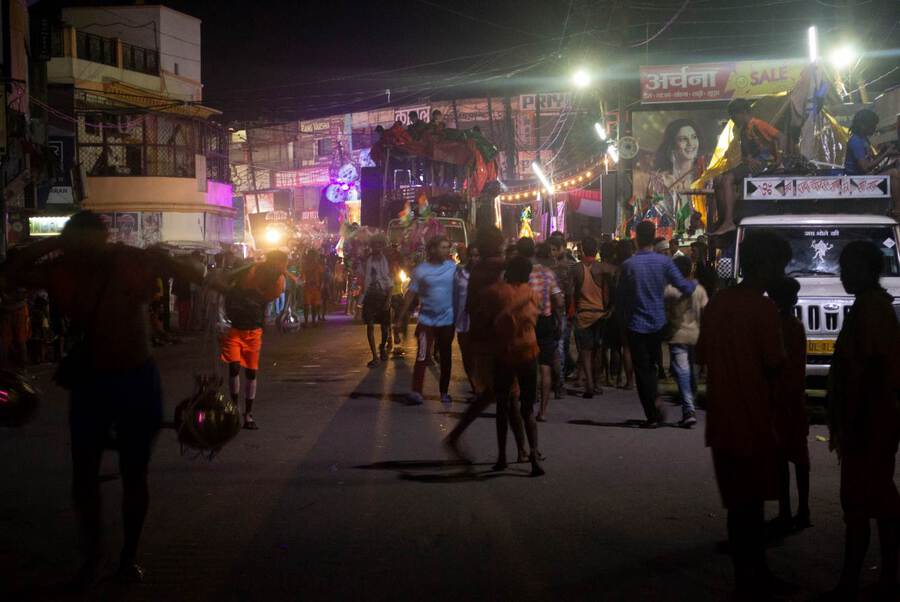
Figure 20. Kanwars crossing Shiv Chowk at night. Photo credit: S. Bharat. (2019).
One pilgrim described the escalating arms race of massive mobile DJs as a form of “taakat pradarshan” or show of strength and power. The pinnacle of this practice is the “soundcheck”, the local name for tracks produced specifically for DJ battles that take place when mobile DJs cross paths along the pilgrimage route. Videos of DJ battles from the pilgrimage abound on the internet and they’re a way of mobile DJ companies to build a reputation.
DJ Battle (Mᴀɴ ᴋᴀʀᴀɴ Gᴀᴍɪɴɢ 2019)
The raspy, booming, saw tooth wave heavy instrumental tracks designed to show off the power of the system are often a stage for a phallic, masculine exercise of one-upmanship evident in the body language of the two crews, the pelvic thrusts and gestures, and macho posturing (in some cases, bodybuilders accompany the crew, flexing their muscles with the bass in the background). Banter between the mobile DJ crews and the pilgrims they accompany is a big part of the DJ battle. The banter is a composite of speech, gestures, and samples of dialogue from popular media and films. Winning the listening public over to your side is as much about the banter as it is about sound.
The North Indian DJ battle is largely focused on the machinery itself, and the crew’s ability to operate it and push it to its limit. The sound is a means to exhibit the power of the equipment with the victor being the one who is able to deliver the biggest "punch". But insofar as this victory is determined by the response of the public, the "punch" cannot be reduced to a purely measurable property like decibel levels. It is a composite affective response to the affordances of the equipment, which includes the visual appearance and spectacle of the mobile DJ, the sound, and the behaviour of the crew and the operator on the mic.
In the global North, club cultures are often associated with communities and subcultures alienated from the "mainstream" by class, gender, race and sexuality. Analytical categories and frameworks for the study of EDMCs have historically emerged out of this context. Scholarship on this subject builds on the broad premise that electronic dance music marks a transition from the logic of the song to the logic of the track, departing from the strophic structure of the song towards an exploration of repetition, rhythms and non-Cartesian modes of listening (Eshun 1988, Reynolds 2013). In India the nightclub and the rave are spaces typically associated with an urban "Westernized" elite. In order to grasp fully the place of electronic dance music in such contexts, it is critical to expand our imagination beyond the club floor to other manifestations of EDMC. In the kanwar pilgrimage public spaces like the riverbank and the interstate highway are transformed into staging grounds for dance music. The soundtrack of the kanwar yatra, with its emphasis on the punch over seamlessness and its abrupt transitions disrupts the logic of the song. But it does so not in the direction of the groove, but towards a more fragmented formation whose genealogy is partly grounded in kanwar music’s sources and partly in a performative space where dancing is not a singular, continuous act but one among many expressions of ludic energy embedded within the flow of religious practice. In the process, mobile DJ culture in North India has developed its own vocabulary of music production and listening distinct from the club. Theorisations of electronic music derived from Euro-American club contexts cannot sufficiently account for the trajectories of EDMCs in regional, non-metropolitan mediascapes. The global spread of electronic music underscores the need for locally grounded, context-specific ontologies and vocabularies of analysis.
This article is based on a research project titled "Soundtracking the Kanwar Yatra: a study of popular music and religion in North India" supported by the India Foundation for the Arts (IFA) Arts Research Grant.
Bharat S. is an archivist at the French Institute of Pondicherry and an anthropologist by training. Email: bharatiyer08@gmail.com
Eshun, Kodwo. 1998. More Brilliant Than the Sun: Adventures in Sonic Fiction. Quartet Books.
Manuel, Peter. 2015. “The Intermediate Sphere in North Indian Music Culture: Between and Beyond ‘Folk’ and ‘Classical’”. Ethnomusicology 59(1): 82–115. <https://doi.org/10.5406/ethnomusicology.59.1.0082>.
Reynolds, Simon. 2013. Generation Ecstasy: Into the World of Techno and Rave Culture. New York: Routledge.
Sterne, Jonathan. 2013 “Soundscape, Landscape, Escape”. In Soundscapes of the Urban Past, ed. Karin Bijsterveld, 181–94. Bielefeld: Transcript Verlag.
Iyer, Bharat. “KNWSS01”. Soundcloud audio, 11:23, 2019.
<https://soundcloud.com/bharat-iyer-3/knwss01>.
Dj Somvir Muanaa. “नक़ली भाँग_Nakli Bhang (Dj Remix ) ll Rajbala Bahadurgarh ll Bhole Song Herd Bass Dj Somvir Muanaa”. YouTube, 5:15. Uploaded on 12 Jul 2021.
<https://www.youtube.com/watch?v=FswCfHSo3Bk> (accessed on 28 Aug 2021).
Mᴀɴ ᴋᴀʀᴀɴ Gᴀᴍɪɴɢ. “RAAVAN DJ vs RAAVAN DJ”. YouTube, 10:16. Uploaded on 23 July 2019.
<https://www.youtube.com/watch?v=P-BOj8b9wuE> (accessed on 30 June 2020).
Sony Music India. “Kailash Kher - Bam Lahiri”. YouTube, 4:11. VEVO. Uploaded on 22 May 2014.
<https://www.youtube.com/watch?v=Tn3fQz9kZzc> (accessed 28 Aug 2021).
Supertone Regional. “Haryanvi 2018 Song -भोला आ गया Whatsapp पे | Shiv Bhajan | Bhola Aa Gaya Whatsapp Pe | Tanu and Manu”. YouTube, 3:26. Uploaded 18 Dec 2017.
<https://www.youtube.com/watch?v=YCy_vdSjh3E> (accessed on 28 Aug 2021).
TauWood. “Nakli Bhang (Remix) ll नकली भांग ll Superhit Shiv Song 2017 ll Rajbala Bahadurgarh || Tau Wood”. YouTube, 5:14. Uploaded 21 Jun 2017.
<https://www.youtube.com/watch?v=RA5C3SRheoY> (accessed 28 Aug 2021).
[1] Sawan is the fifth month of the lunar Hindu calendar, which overlaps with July and August in the Gregorian calendar.
[2] Haridwar is the most popular starting point for the kanwar yatra at present, but there are other places too—Gangotri, Gaumukh, Sultanganj, and Tarakeshwar to name some, all on the banks of the river Ganga. Of these Haridwar, in the Himalayan state of Uttarakhand, and Sultanganj in Bihar are by far the two most popular. Gaumukh and Gangotri are further upstream of the river Ganges, nestled deep in the mountains, making the journey longer and more arduous, meant only for the really determined pilgrims. The pilgrimage route originating at Tarakeshwar in the eastern state of West Bengal is shorter and popular mainly within its immediate vicinity.
[3] Bhola is Hindi for a naive or simple person and Bholenath is the Lord of the Simple People. In taking on the term bhole the pilgrims present themselves as simple devotees of Siva, granting them a moral legitimacy and dignity that their customary place in the lower rungs of Indian society denies them in everyday life.
[4] In everyday North Indian parlance the term “DJ” refers to the machine itself, rather than the human operating it. The person behind the console is called an operator.
[5] Steps along the banks of a river commonly used for bathing and washing clothes, as well as for ritual purposes.
[6] In local parlance the process of turning on the mobile DJ is known as “sound kholna” or opening the sound.
[7] These labels emerged as part of a broader trend in North Indian popular regional music that developed in the 1980s with the introduction of cassette tapes. The best example of this mediascape is T-Series, a record company founded in the 1980s that started making pirated cassette tapes and grew over the years into a giant corporation with a very diverse catalogue of Bollywood and regional music, setting the template for a number of regional record labels like Mor Music, Tau Company and Sonotek that have come up since. With the rise of mobile internet and streaming services, regional labels are now largely dependent on revenue from their YouTube channels. These companies either produce their own music or purchase the rights to songs from the artist and upload them on their channels. For their part musicians gain visibility from these uploads and make most of their money from live performances.
[8] Pankaj, interview with author (Manglaur), 23 July 2019.
[9] A wedding crew consists of an operator and two helpers who accompany the equipment. An operator makes around INR 1,000 per gig, while helpers make INR 500.
[10] Nitin, interview with author (phone call), 8 March 2020.